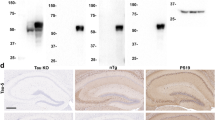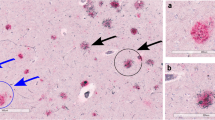Abstract
In this report we quantitatively assess the numbers of intracellular and extracellular neurofibrillary tangles (NFT) in the brains of a series of individuals with Alzheimer's disease and of controls and correlate these with neuronal loss. Our data indicate that in some cases, NFT are not removed from the brain throughout the disease process. This finding, together with our previous demonstration of carbonyl-related modifications in NFT, provides additional evidence that the protein constituents of NFT are resistant to proteolytic removal, possibly as a result of extensive cross-links. Additionally, correlation between the number of NFT and neuronal loss indicates that there are at least two distinct mechanisms responsible for neuronal death in Alzheimer's disease that are directly and indirectly related to the presence of neurofibrillary pathology.
Similar content being viewed by others
References
Abercrombie M (1946) Estimation of nuclear populations from microtome sections. Anat Rec 94:239–247
Blessed G, Tomlinson BE, Roth M (1968) The association between quantitative measures of dementia and senile changes in the cerebral grey matter of elderly subjects. Br J Psychol 114:797–801
Braak H (1980) Architectonics of the human telencephalic cortex. In: Braitenberg V, Barlow HB, Bizzi E (eds) Studies of brain function, vol. 4. Springer, Berlin Heidelberg New York, pp 1–147
Braak H, Braak E (1985) On areas of transition between entorhinal allocortex and temporal isocortex in the human brain. Normal morphology and lamina-specific pathology in Alzheimer's disease. Acta Neuropathol (Berl) 68:325–332
Brion JP, Couck AM, Passareiro E, Flament-Durand J (1985) Neurofibrillary tangles of Alzheimer's disease: an immunohistochemical study. J Submicrosc Cytol 17:89–96
Galloway PG, Mulvihill P, Siedlak S, Mijares M, Kawai M, Padget H, Kim R, Perry G (1990) Immunochemical demonstration of tropomyosin in the neurofibrillary pathology of Alzheimer's disease. Am J Pathol 137:291–300
Grundke-Iqbal I, Iqbal K, Tung Y-C, Quinlan M, Wisniewski HM, Binder LI (1986) Abnormal phosphorylation of the microtubule-associated protein tau in Alzheimer cytoskeletal pathology. Proc Natl Acad Sci USA 83:4913–4917
Kosik KS, Joachim CL, Selkoe DJ (1986) Microtubule-associated protein tau. A component of Alzheimer paired helical filaments. Proc Natl Acad Sci USA 83:4044–4048
Mann DMA, Yates PO, Marcyniuk B (1985) Correlation between senile plaque and neurofibrillary tangle counts in cerebral cortex and neuronal counts in cortex and subcortical structures in Alzheimer's disease. Neurosci Lett 56:51–55
Mann DMA, Marcyniuk B, Yates PO, Neary D, Snowden JS (1988) The progression of the pathological chanes of Alzheimer's disease in frontal and temporal neocortex examined both at biopsy and at autopsy. Neuropathol Appl Neurobiol 14:177–195
Perry G, Smith MA (1993) Senile plaques and neurofibrillary tangles: what role do they play in Alzheimer disease? Clin Neurosci 1:199–203
Perry G, Rizzuto N, Autillio-Gambetti L, Gambetti P (1985) Paired helical filaments from Alzheimer disease patients contain cytoskeletal components. Proc Natl Acad Sci USA 82:3916–3920
Probst A, Ulrich J, Heitz U (1982) Senile dementia of Alzheimer type: astroglial reaction to extracellular neurofibrillary tangles in the hippocampus. Acta Neuropathol (Berl) 57:75–79
Siedlak SL, Cras P, Kawai M, Richey P, Perry G (1991) Basic fibroblast growth factor binding is a marker for extracellular neurofibrillary tangles in Alzheimer disease. J Histochem Cytochem 39:899–904
Smith MA, Perry G (1994) Alzheimer disease: an imbalance of proteolytic regulation? Med Hypotheses 42:277–279
Smith MA, Kalaria RN, Perry G (1993) 295-1-trypsin immunore-activity in Alzheimer disease. Biochem Biophys Res Commun 193:579–584
Smith MA, Taneda S, Richey PL, Miyata S, Yan S-D, Stern D, Sayre LM, Monnier VM, Perry G (1994) Immunocytochemical demonstration of advanced Maillard reaction products in Alzheimer disease pathology. Proc Natl Acad Sci USA 91:5710–5714
Smith MA, Richey PL, Kutty RK, Taneda S, Monnier VM, Sayre LM, Perry G (1994) Advanced Maillard reaction end products, free radicals and protein oxidation in Alzheimer disease. Ann NY Acad Sci 738:447–454
Smith MA, Kutty RK, Richey PL, Yan S-D, Sterm D, Chader GJ, Wiggert B, Petersen RB, Perry G (1994) Heme oxygenase-1 is associated with the neurofibrillary pathology of Alzheimer disease. Am J Pathol 145:42–47
Sternberger LA, Sternberger NH (1983) Monoclonal antibodies distinguish phosphorylated and non phosphorylated forms of neurofiliments in situ. Proc Natl Acad USA 80:6126–6130
Sumpter PQ, Mann DMA, Davies CA, Yates PO, Snowden JS, Neary D (1986) An ultrastructural analysis of the effects of accumulation of neurofibrillary tangles in pyramidal cells of the cerebral cortex in Alzheimer's disease. Neuropathol Appl Neurobiol 12:305–319
Tabaton M, Cammarata S, Mancardi G, Manetto V, Autilio-Gambetti L, Perry G, Gambetti P (1991) Ultrastructural localization of β-amyloid, τ, and ubiquitin epitopes in extracellular neurofibrillary tangles. Proc Natl Acad Sci USA 88:2098–2102
Vande Weghe J, Cras P, Kawai M, Siedlak SL, Tabaton M, Greenberg B, Perry G (1991) Dystrophic neurites infiltrate extracellular neurofibrillary tangles in Alzheimer disease. Brain Res 560:303–305
Wolozin BL, Pruchnicki A, Dickson DW, Davies P (1986) A neuronal antigen in the brains of Alzheimer patients. Science 232:648–650
Wood JG, Mirra SS, Pollock NJ, Binder LI (1986) Neurofibrillary tangles of Alzheimer disease share antigenic determinants with the axonal microtubule-associated protein τ. Proc Natl Acad Sci USA 83:4040–4043
Yamaguchi H, Nakazato Y, Kawarabayashi T, Ishiguro K, Ihara Y, Morimatsu M, Hirai S (1991) Extracellular neurofibrillary tangles associated with degenerating neurites and neurophil threads in Alzheimer-type dementia. Acta Neuropathol 81:603–609
Yan S-D, Chen X, Schmidt A-M, Brett J, Godman G, Zou Y-S, Scott CW, Caputo C, Frappier T, Smith MA, Perry G, Yen S-H, Stern D (1994) Glycated tau protein in Alzheimer disease: a mechanism for induction of oxidant stress. Proc Natl Acad Sci USA 91:7787–7791
Author information
Authors and Affiliations
Rights and permissions
About this article
Cite this article
Cras, P., Smith, M.A., Richey, P.L. et al. Extracellular neurofibrillary tangles reflect neuronal loss and provide further evidence of extensive protein cross-linking in Alzheimer disease. Acta Neuropathol 89, 291–295 (1995). https://doi.org/10.1007/BF00309621
Received:
Revised:
Accepted:
Issue Date:
DOI: https://doi.org/10.1007/BF00309621




